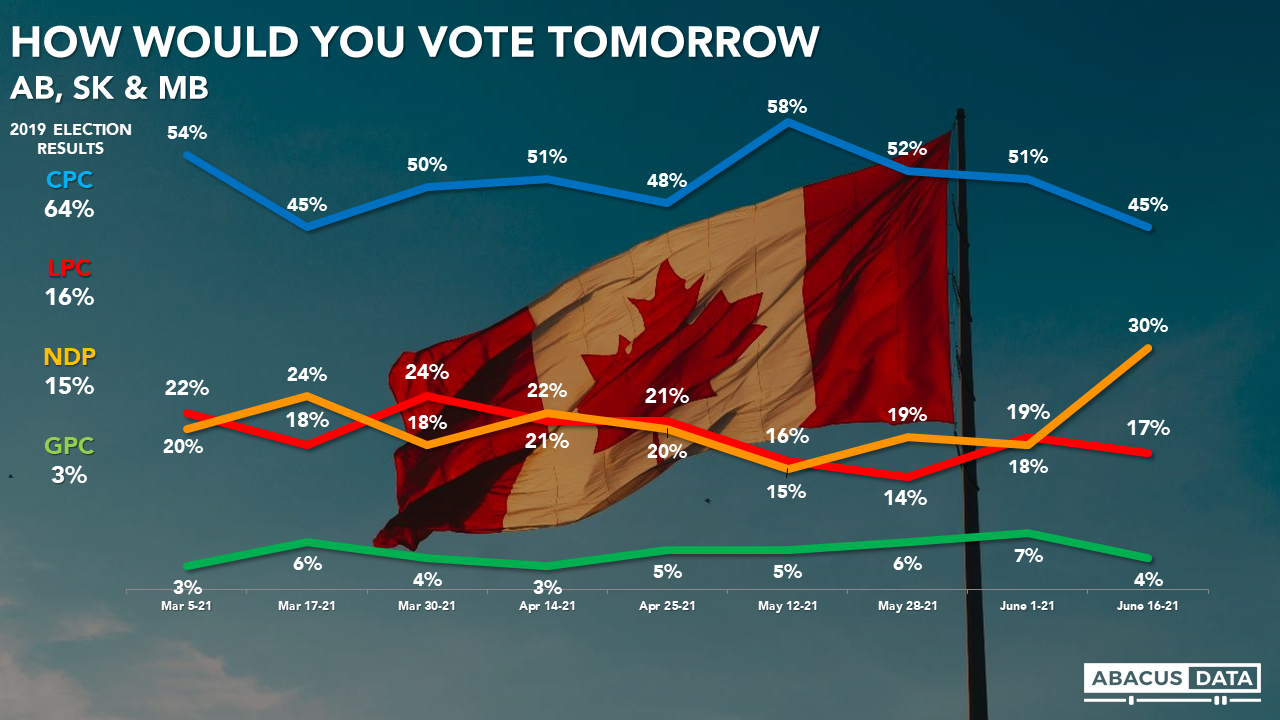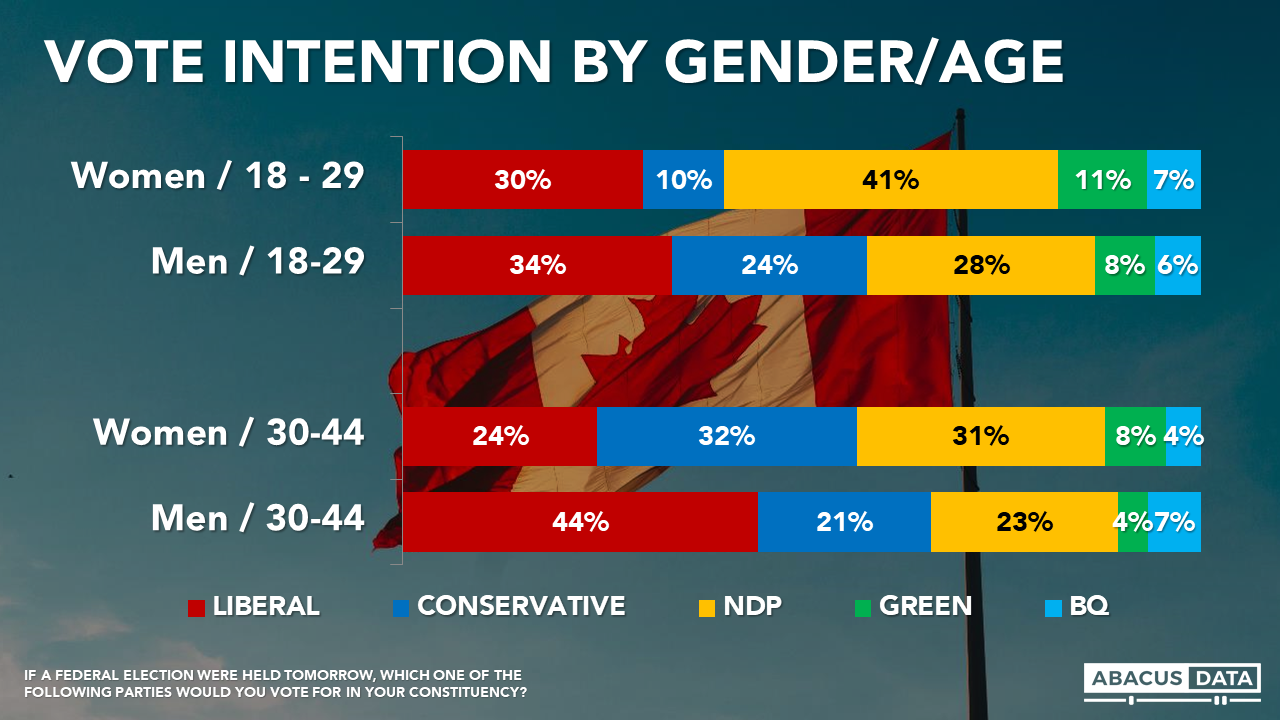Liberals lead by 5 but NDP makes big gains
June 17, 2021
We just completed a national survey of 1,500 Canadian adults (from June 10 to 16, 2021).
Here’s what the survey found:
NATIONAL MOOD CONTINUES TO IMPROVE
There is a continuing upswing in the number of people who say Canada is heading in the right direction, from an ebb of 33% on April 21st to today’s level of 47%. The number of people who say the country is off on the wrong track is 35%, with 18% unsure one way or the other.

“Right track” perceptions are the plurality view everywhere except in the Prairie provinces. Demographically the only group that stands out with a plurality “wrong direction” view is women under 30 (32% right direction – 35% wrong direction).
CURRENT VOTING INTENTION
If an election were held now, the Liberals would win 34% of the vote, the Conservatives 29%, the NDP 21%, the Green Party 6% and the BQ 35% in Quebec. The NDP is up 5-points since the beginning of the month thanks to a spike in the Prairies.


In BC we see a continuing three-way battle.
The Conservatives continue to hold wide leads in the Prairies, although seeing the NDP at 28% in Alberta and 32% in Saskatchewan/Manitoba is worth noting.
The Liberals have a 12-point lead in Ontario, are deadlocked with the BQ in Quebec, and hold a 16-point lead in Atlantic Canada.

Among women under 30, the NDP leads the Liberals by 11 points. Among women aged 30 to 44, the Liberals trail both the Conservatives and the NDP.

LEADER IMPRESSIONS
Justin Trudeau enjoys a positive impression among 39% and finds negative impressions among 39%, for a net score of 0. Trudeau is -2 among women under 30. He is -11 in BC, +5 in Ontario, +20 in Quebec, and +11 in Atlantic Canada.
Erin O’Toole enjoys a positive impression among 19% and finds negative impressions among 36%, for a net score of -17. O’Toole is -21 in BC, -6 in Alberta, -19 in Man/Sask, -20 in Ontario, -16 in Quebec and -18 in Atlantic Canada. He is -18 among men and -17 among women. Among 2019 Conservative voters 56% express a positive view with 26% neutral and 10% negative.
Jagmeet Singh enjoys a positive impression among 32% and finds negative impressions among 26% for a net +6. Singh is +6 in BC, -3 in Alberta, +7 in Man/Sask, +16 in Ontario, -4 in Quebec and +1 in Atlantic Canada. He is 0 among men and +12 among women, including +32 among women under 30.

Asked which of the national party leaders they would like to see become Prime Minister after the next election, Mr. Trudeau is the choice of 30%, Mr. O’Toole (20%) and Mr. Singh (16%).
On this question, Mr. Singh is the first choice of voters under 30 and the second choice of voters 30-44.
Among all women voters, Mr. Trudeau is the first choice of 29%, with Mr. O’Toole and Mr. Singh tied at 18%.


UPSHOT
According to Bruce Anderson: “As speculation about a late summer election heats up, these numbers offer mixed signals for the Liberals, flashing risk signals for the Conservatives, and plenty of opportunity for the NDP. BC, Quebec, and voters under 45, maybe especially those under 30 – these look to be the key battlegrounds in a campaign in the near term. Mr. Singh’s opportunity underscores that there is a lot of demand for progressive policy and that he has made a connection with younger voters. The warning signs for Mr. O’Toole are about tepid feelings for him among Conservative voters, and at the same time, he hasn’t been able to attract much interest from swing voters around the centre of the spectrum. These numbers do not offer the Liberals a clear path to a majority – especially given the tightness of the contest with the BQ in Quebec and the wandering gaze of younger voters towards the NDP.”
According to David Coletto: “As the summer is set to begin and talk of a late summer or early fall election call grows, the political environment remains quite competitive. The Liberals have an advantage but their support among younger women looks quite tenuous in our data.
The NDP has gained quite a bit of ground in the Prairies while the Conservatives remain stuck at around 30% – a place they have been for quite some time in our tracking.
An improving mood has not translated into more support for the incumbents which might foretell how Canadians could react if asked to vote in an election later this year.”
METHODOLOGY
The survey was conducted with 1,500 Canadian adults from June 10 to 16, 2021. A random sample of panelists were invited to complete the survey from a set of partner panels based on the Lucid exchange platform. These partners are typically double opt-in survey panels, blended to manage out potential skews in the data from a single source.
The margin of error for a comparable probability-based random sample of the same size is +/- 2.6%, 19 times out of 20.
The data were weighted according to census data to ensure that the sample matched Canada’s population according to age, gender, educational attainment, and region. Totals may not add up to 100 due to rounding.

ABOUT ABACUS DATA
We are the only research and strategy firm that helps organizations respond to the disruptive risks and opportunities in a world where demographics and technology are changing more quickly than ever.
Find out more about what we are doing to help clients respond to the COVID-19 pandemic.
We are an innovative, fast-growing public opinion and marketing research consultancy. We use the latest technology, sound science, and deep experience to generate top-flight research-based advice to our clients. We offer global research capacity with a strong focus on customer service, attention to detail and exceptional value.
We were one of the most accurate pollsters conducting research during the 2019 Canadian Election.

Contact us with any questions.
Find out more about how we can help your organization by downloading our corporate profile and service offering.




